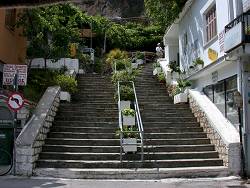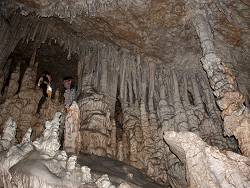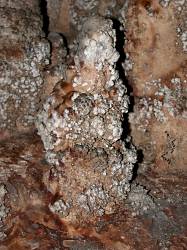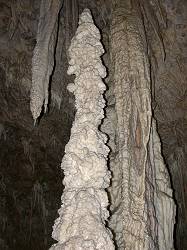Σπηλαιο Πηραματοσ
Spelaio Peramatos - Perama Cave - Cave of Perama
Useful Information


| Location: |
19, Spilaiou, Σπηλαίου 19, Πέραμα, Perama 455 00.
4 km from Ioannina, in Perama, at the foot of Mt. Goritsa. Follow the main road of Ioannina to the north, the 20/E90. At the northern end of the city is a turnoff right towards Metsovo, Trikala, Larissa, 6/E92. Perama is the first village after about 2 km. Try to park outside the city at the road and walk the left road in, about 250 m to the cave entrance. (39.694978, 20.846500) |
| Open: |
All year daily 9-17. [2024] |
| Fee: |
Adults EUR 8, Children EUR 5, Students EUR 4. Groups (): Adults EUR 6. [2024] |
| Classification: |
 Karst Cave Karst Cave
 cave with a view. cave with a view.
|
| Light: |
 Electric Light Electric Light
 Coloured Light Coloured Light
|
| Dimension: | T=18 °C, lake 14 °C. |
| Guided tours: | L=1,100 m, D=45 min. |
| Photography: | allowed |
| Accessibility: | no |
| Bibliography: |
P Pavlakis, et al (1995?):
New Evidence of Middle Pleistocene mammalian fauna from the Perama Cave (Ioannia, Greece),
The Palaeolithic Archaeology of Greece and adjacent area.
British Studies in Archaeology, Vol 3. |
| Address: |
Perama Cave, 19, Spilaiou, Perama 455 00, Tel: +30-2651-081521.
E-mail: Σπήλαιο Περάματος, Σπηλαίου 19, Πέραμα 455 00, Tel: +30-2651-081521. E-mail: |
| As far as we know this information was accurate when it was published (see years in brackets), but may have changed since then. Please check rates and details directly with the companies in question if you need more recent info. |
|
History
| 1940 | discovered by a resident of the village who was looking for a shelter to avoid bombardments during the Greek-Italian war. |
| 1951-1955 | the speleologists Ioannis Petrocheilos and Anna Petrocheilou explored the cave and discovered the teeth and bones of ancient cave bears. |
| 1956 | opened to the public. |
Description




Mt. Goritsa risies above the village of Perama and
 Limni Ioanninon
(Lake Ioannina).
Σπήλαιο Περάματος (Spelaio Peramatos, Perama Cave) is located inside this hill.
The cave is part of the bed of an underground river and was formed in the pre-Quaternary period, about 1.5 Million years ago.
The river formed three cave levels.
Limni Ioanninon
(Lake Ioannina).
Σπήλαιο Περάματος (Spelaio Peramatos, Perama Cave) is located inside this hill.
The cave is part of the bed of an underground river and was formed in the pre-Quaternary period, about 1.5 Million years ago.
The river formed three cave levels.
The most famous feature in this cave is the stalagmite known as the Cross. It started as a cloven stalagmite, developed from drops falling from two stalactites above. Once the tip of one stalactite broke and fell down. But instead of hitting the floor, it came to rest between the twin summits of the stalagmite. Subsequent growth first anchored the stalactite and then continued the growth of the stalagmite, creating a cross.
According to local lore, the cave was known before 1900, and the bey Holiasis Efentis closed it around 1907 for security reasons. There are no documents or pictures who pove this though. But that the cave was discovered by a citizen looking for a shelter to avoid bombardments during the Greek-Italian war in 1940 is undisputed. During the following years, many villagers hid in the cave during airstrikes. But they used only the entrance section. It was followed by a 100 m crawl, and it seems no one ever thought about crawling this far. This part of the cave was first explored in 1951 by the speleologists Ioannis Petrocheilos and Anna Petrocheilou. The explored the cave numerous times between 1953 and 1961 and discovered huge corridors, extensive chambers, and impressive speleothems.
In 1956 the tooth of a cave bear, the first ever discovered in Greece, was found in this cave by Anna Petrocheilou. An excavation, conducted by Ioannis Petrocheilos, her husband, in the same year, discovered teeth and bones of an entire cave bear family, which lived some 600.000 years ago. He also observed a new species of dolichopod. This was examined by the French bio-speleologist Pierre Alfred Chappuis, who named it Dolichopod petrocheilosus in honour of its finder. This discovery prompted the Swedish specialist K. Lindberg to undertake further bio-speleological research, with the result that the following orders of arthropods (invertebrate animals) were found: Oligochaeta, Arpacticidae, Isopoda, Amphipoda, Diplopoda, Collembola, Arachnidae, Acarea as well as the larvae of various insects.
The Perama cave tour is a bit strenuous, the cave path is often narrow and goes up and down between formations. Most of the time the path has no rails, the steps all have different heights and are sometimes very high. And at the end, there is a pretty steep ascent of at least 50 meters to the exit, so the cave is definitely not wheelchair-accessible. The cave administration tells there are 163 steps to climb. But the survivor is rewarded by an exceptional view on Ioannina. And then you have to walk back across the hill.
The cave is well worth a visit, and we do not want to restrain cave visitors, but as the cave administration does not tell this, we have to do it: the cave is not suitable for people with any disease which does not allow physical stress, like heart diseases. We also suppose that people which have problems with walking on a rough path or have problems with balance, relinquish to visit the cave. Walking shoes are recommended. Despite the rather low temperature, a T-shirt seems sufficient, as you get a lot to do inside.
The cave has very nice and varied formations, but unfortunately they are poorly lit. All cave lamps are in a very intensive yellow, which makes the cave look like inside a road tunnel. The really nice colours of the formations become various forms of yellowish. We suppose this was done to reduce lamp flora, and it seems to work pretty well. Unfortunately, it makes the whole cave look, well, yellow. So we must criticize that the cave visit is not half as good as it could be with good light. The images on these pages, made with flash, do not show this yellow light. Very much appreciated was the fact, that photography was allowed in the cave, which is not common in Greek show caves. Now they have replaced the yellow light partly by blue light, which is actually worse.
A cave visit is a very personal thing, and the quality of the tours often depends on the guide one gets. But the two descriptions of cave visits below show some similarities, which are surprising, as there were 15 years between the two visits.
The new Κέντρο Προβολής Σπηλαίου & Υποδοχής Επισκεπτών «Άννα Πετροχείλου» ("Anna Petrocheilou" Cave Promotion & Visitor Reception Center) is a sort of Visitor Center and museum. It is located at the main highway on the southern side of the village. On one side is a huge car park for buses and cars, on the other side where the road through town, which leads to the cave after 500 m, branches of, is the new center. Named after the most famous Greek speleologist Anna Petrocheilou it offers tourist information as well as cafenion and refreshments. The museum includes an exhibition of geological and palaeontological findings and a projection room, which shows a twenty-minute documentary on The world of the Caves. The documentary was edited by a team of scientists from the Athens Ephorate of Paleoanthropology and Speleology of the Ministry of Culture. The topics are the creation and types of caves, their decoration, palaeontological and archaeological finds, fauna and the relationship of people with caves.
From the center and the car park it is a 500 m hike through the village up the main street. In the cave tour description below, several funny problems with this were described, but this was 20 years ago. Today there is the famous tourist train with two closed heated wagons with a capacity of 50 seated people. It is a shuttle from the car park to the cave and back and seems to operate while the cave is open. We strongly recommend parking on the main car park and either take the train or walk.

|
| Perama Gallery |
 Greece 1987 by Anne Oldham (1987).
Greece 1987 by Anne Oldham (1987). Search DuckDuckGo for "Perama Cave"
Search DuckDuckGo for "Perama Cave" Google Earth Placemark
Google Earth Placemark OpenStreetMap
OpenStreetMap PERAMA CAVE, official website (visited: 02-NOV-2024)
PERAMA CAVE, official website (visited: 02-NOV-2024) Index
Index Topics
Topics Hierarchical
Hierarchical Countries
Countries Maps
Maps